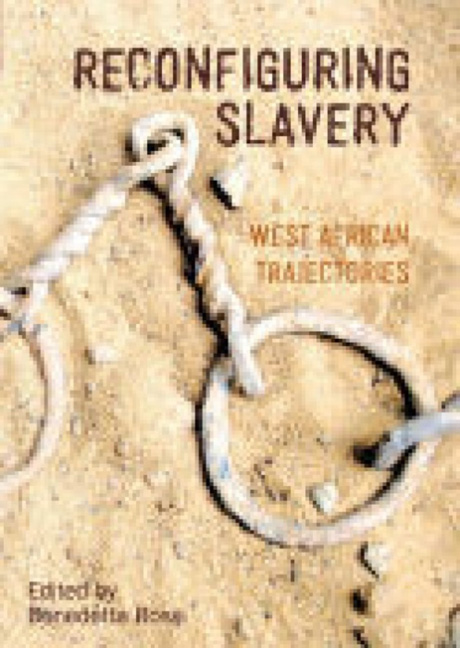Book contents
- Frontmatter
- Content
- List of Figures
- Notes on Contributors
- Preface
- A Note on Language
- Preface to the Second Edition
- 1 Introduction: Rethinking Slavery in West Africa
- 2 Slave Descent and Social Status in Sahara and Sudan
- 3 African American Psychologists, the Atlantic Slave Trade and Ghana: A History of the Present
- 4 After Abolition: Metaphors of Slavery in the Political History of the Gambia
- 5 Islamic Patronage and Republican Emancipation: The Slaves of the Almaami in the Senegal River Valley
- 6 Curse and Blessing: On Post-slavery Modes of Perception and Agency in Benin
- 7 Contemporary Trajectories of Slavery in Haalpulaar Society (Mauritania)
- 8 Slavery and Politics: Stigma, Decentralisation and Political Representation in Niger and Benin
- 9 Slavery and Migration: Social and Physical Mobility in Ader (Niger)
- 10 Discourses on Slavery: Reflections on Forty Years of Research
- Glossary of Foreign Words
- Index
4 - After Abolition: Metaphors of Slavery in the Political History of the Gambia
- Frontmatter
- Content
- List of Figures
- Notes on Contributors
- Preface
- A Note on Language
- Preface to the Second Edition
- 1 Introduction: Rethinking Slavery in West Africa
- 2 Slave Descent and Social Status in Sahara and Sudan
- 3 African American Psychologists, the Atlantic Slave Trade and Ghana: A History of the Present
- 4 After Abolition: Metaphors of Slavery in the Political History of the Gambia
- 5 Islamic Patronage and Republican Emancipation: The Slaves of the Almaami in the Senegal River Valley
- 6 Curse and Blessing: On Post-slavery Modes of Perception and Agency in Benin
- 7 Contemporary Trajectories of Slavery in Haalpulaar Society (Mauritania)
- 8 Slavery and Politics: Stigma, Decentralisation and Political Representation in Niger and Benin
- 9 Slavery and Migration: Social and Physical Mobility in Ader (Niger)
- 10 Discourses on Slavery: Reflections on Forty Years of Research
- Glossary of Foreign Words
- Index
Summary
Beyond Slavery: A Trajectory of Historical Metamorphosis
On a small island at the mouth of the River Gambia constantly menaced by erosion, the ruins of Fort St James – which UNESCO inscribed on the World Heritage List in 2003 – testify to the secular engagement of this area of West Africa with the traffic in slaves and with slavery as a social institution (Curtin, 1975; Meagher and Samuel, 1998; Wright, 2004). From the second half of the fifteenth century slaves were traded from the Senegambia to the Iberian Peninsula. By the sixteenth century the whole region participated in the transatlantic slave trade (Barry, 1998; Hair, 1980; Klein, 1990). The age of enslavement did not end with the closure of the Atlantic markets in the first half of the nineteenth century, as slavery had become a part of the economy of local societies. This institution began to die only in the 1890s. The first ordinance banning slave raiding and slave-trading from the territories of the River Gambia was promulgated in 1894 after the establishment of the British Protectorate. Colonial officials believed that the outlawing of the traffic in slaves would facilitate a smooth transition towards freedom in the long run (Bellagamba, 2005; Klein, 1998; Swindell and Jeng, 2006). The subsequent story was more complicated. Masters lamented their lost privileges. Conversely, slaves began their fight for upward mobility. Eventually, the legal status of slavery was completely abolished in 1930. Calling somebody a slave became a criminal offence, a piece of legislation which was included in the Laws of the Gambia (Ames, 1967) at the time of independence. ‘Is it your father or your mother who bought me?’ a descendant of slaves may currently say when annoyed by attempts at recalling in public his or her servile origins.
As a social relationship slavery has survived its legal ending, though in circumscribed niches. Throughout the twentieth century, ‘slaves’ and ‘masters’ engaged in a complex process of reformulation of their reciprocal social and moral obligations (Cooper, 2000a; Klein, 2005b). From the point of view of slaves, there were two options. Both were practised diversely in different areas of the country. The proportion is difficult to calculate given the lack of consistent colonial evidence on this point.
- Type
- Chapter
- Information
- Reconfiguring SlaveryWest African Trajectories, pp. 63 - 84Publisher: Liverpool University PressPrint publication year: 2009



